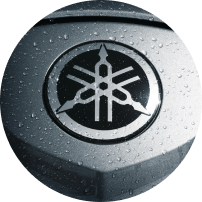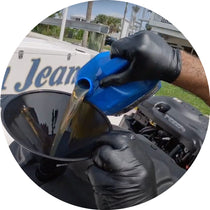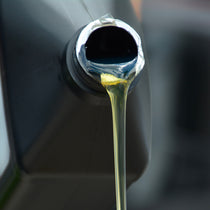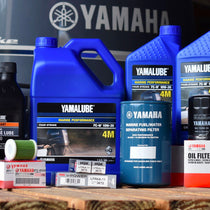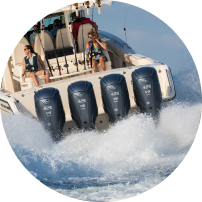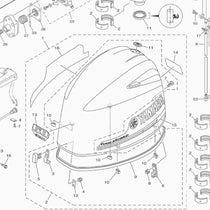

Guide to a Yamaha Jet Propulsion System
Yamaha’s jet propulsion system powers its WaveRunners and Yamaha jet boats, using the same core technology in different sizes. Instead of a traditional propeller, Yamaha's system draws water into an enclosed pump, where an impeller accelerates it before forcing it out through a directional nozzle. This process generates thrust and enables precise control over movement.
Jet propulsion differs significantly from propeller-driven systems, offering safety, handling, and shallow-water capability advantages while presenting efficiency and low-speed maneuverability challenges. Understanding how the system works, along with its pros and cons, helps boaters decide whether a Yamaha jet boat or Yamaha WaveRunner is the right choice.
How Yamaha’s Jet Propulsion System Works
Jet propulsion systems pull water into a pump, accelerate it with an impeller, and expel it through a nozzle at high speed. This system differs from traditional boats that use an external propeller to push water backward. Yamaha’s system consists of key components that work together to produce smooth, efficient movement:
Water Intake
Located on the underside of the hull, the intake allows water to enter the pump.
Impeller
A rotating component that accelerates water through the system, generating thrust.
Pump Housing
Encases the impeller, optimizing the water flow for maximum efficiency.
Nozzle & Steering Mechanism
Controls the direction of water output, allowing for turns and precise maneuvers.
The entire system remains enclosed within the hull, eliminating many risks and limitations associated with traditional outboard or sterndrive propulsion.
Acceleration & Handling
One of the defining characteristics of jet propulsion is its ability to provide immediate acceleration. Because water moves directly through the pump without the lag of a traditional transmission system, jet boats respond instantly when power is applied, making them highly maneuverable, particularly at higher speeds.
Steering is also unique compared to propeller-driven boats. Instead of relying on a rudder, Yamaha’s system directs thrust by adjusting the nozzle at the rear of the pump. Turning without a rudder allows for sharp, responsive handling, especially in high-speed situations.
Advantages of Jet Propulsion
Yamaha’s jet propulsion system offers several advantages over traditional propeller-driven boats, making it a popular choice for recreational boating, watersports, and shallow-water navigation.
1. No Exposed Propeller = Increased Safety
With no spinning propeller beneath the water, jet-powered boats significantly reduce the risk of injury to swimmers, wakeboarders, and anyone in the water. This feature makes jet boats attractive for families and those frequently engaging in water activities.
2. Shallow Water Operation
The enclosed nature of the system allows jet boats to operate in shallower water than traditional propeller-driven boats. Without a lower unit hanging beneath the hull, a Yamaha jet boat can navigate areas with minimal depth, making it ideal for sandbars, rivers, and shallow coastal regions.
3. Instant Acceleration & Quick Maneuvering
Jet propulsion systems deliver immediate power, allowing for faster acceleration than propeller-driven boats. Thrust vectoring, combined with the lack of a shifting transmission, gives jet boats a level of agility unmatched by traditional setups. They can also perform 180-degree spins and rapid directional changes, making them a favorite for high-energy boating experiences.
4. Compact & Spacious Design
Because Yamaha’s jet propulsion system sits entirely inside the hull, the boat's rear section remains open and uncluttered, allowing for a more spacious swim platform and improved interior layouts compared to sterndrive boats, which need room for an engine compartment and propeller system.
5. Reduced Maintenance & Durability
Jet propulsion engines are relatively simple compared to sterndrive or outboard motors. With fewer moving parts exposed to water, Yamaha jet boats require less maintenance related to propeller damage, shaft seals, and lower unit repairs. Yamaha’s closed-loop cooling system also prevents saltwater from circulating inside the engine, reducing corrosion over time.
Disadvantages of Jet Propulsion
Despite its many benefits, jet propulsion has some drawbacks that make it less suitable for certain boating applications. Understanding these trade-offs helps determine if a Yamaha jet boat is the right choice.
1. Reduced Low-Speed Maneuverability
Yamaha jet boats rely on thrust from the propulsion nozzle for steering, making them more challenging to control at low speeds. Unlike traditional boats with a rudder to maintain a steady course, jet propulsion requires active throttle adjustments to maneuver effectively. To address this issue, Yamaha has developed improved control systems like the No Wake Mode™ and Thrust Directional Enhancer (TDE), but handling at slow speeds still requires more skill than with a sterndrive or outboard boat.
2. Susceptibility to Debris
Jet intakes can clog when pulling in seaweed, leaves, or debris from the water. Unlike propeller-driven boats, which can usually power through some obstructions, jet boats may experience reduced performance if foreign objects get sucked into the intake. Yamaha designs its intakes with clean-out ports to quickly remove debris, but this remains a potential downside for those boating in areas with heavy vegetation.
3. Lower Fuel Efficiency at High Speeds
Jet propulsion systems tend to be less fuel-efficient than sterndrive or outboard motors when operating at cruising speeds. Because jet pumps rely on high RPMs to maintain thrust, they can consume more fuel than propeller-driven boats traveling at the same speed. Yamaha’s engine technology advances have improved efficiency, but jet boats may still require more fuel for long-distance cruising.
4. Less Torque for Heavy Loads
Jet propulsion excels in lightweight, high-speed applications but struggles when carrying heavy loads. A fully loaded jet boat may feel sluggish compared to a propeller-driven boat with the same weight, especially when trying to get on plane. Sterndrive boats, in particular, offer better low-end torque for hauling multiple passengers or towing larger watercraft.
Jet Boats vs. Propeller or Sterndrive Powered Boats
For buyers comparing Yamaha jet boats to sterndrive or outboard boats, several key factors come into play:
- Handling & Response – Jet boats offer sharper, more immediate handling, while sterndrives provide smoother control at all speeds.
- Shallow Water Performance – Jet boats excel in low-depth conditions, while sterndrive boats require more clearance.
- Fuel Efficiency – Sterndrive boats generally consume less fuel over long distances.
- Safety & Design – Jet propulsion eliminates exposed propellers, offering a safer experience for swimmers and watersports.
- Maintenance & Durability – Fewer external moving parts make jet propulsion systems easier to maintain in the long run.
Frequently Asked Questions (FAQs) About Yamaha’s Jet Propulsion System
1. How does Yamaha’s jet propulsion system differ from a traditional propeller system?
Yamaha’s jet propulsion system uses an enclosed impeller to pull water into a pump, accelerate it, and force it out through a nozzle to generate thrust. In contrast, a traditional propeller system uses an exposed propeller to push water backward. Jet propulsion eliminates the need for an external propeller, improving safety and enabling operation in shallow water.
2. Can Yamaha jet boats handle rough water?
Yes, but with some limitations. Yamaha jet boats perform well in moderate chop but may not handle rough, open waters as smoothly as larger deep-V hull sterndrive boats. The design of the hull plays a significant role in wave handling, and Yamaha’s models are optimized for stability. Still, boaters should be mindful of conditions when venturing into rough water.
3. What happens if debris gets sucked into the jet intake?
Debris, such as seaweed or small objects, can sometimes clog the intake, reducing performance. Yamaha jet boats feature clean-out ports, allowing operators to remove blockages without getting in the water. Regular maintenance and checking the intake when boating in areas with heavy vegetation can help prevent this issue.
4. Are Yamaha jet boats loud compared to propeller-driven boats?
Older jet boats were known for being louder due to high RPM operation, but in recent models, Yamaha has significantly reduced noise levels. Sound-dampening technologies and improved engine design have made them quieter than older jet boats, though they may still produce more engine noise than some sterndrive boats.
Final Thoughts
Yamaha’s jet propulsion technology continues to evolve, offering boaters a blend of performance, safety, and maneuverability. Understanding both the strengths and limitations of jet propulsion helps make an informed decision about whether a Yamaha jet boat aligns with specific needs and boating environments.
PartsVu offers all of the parts, products, and accessories you need to maintain and enjoy your Yamaha jet boat or WaveRunner to its fullest. Additionally, to make maintenance even easier, we offer Yamaha WaveRunner maintenance kits and Yamaha jet boat service kits.




